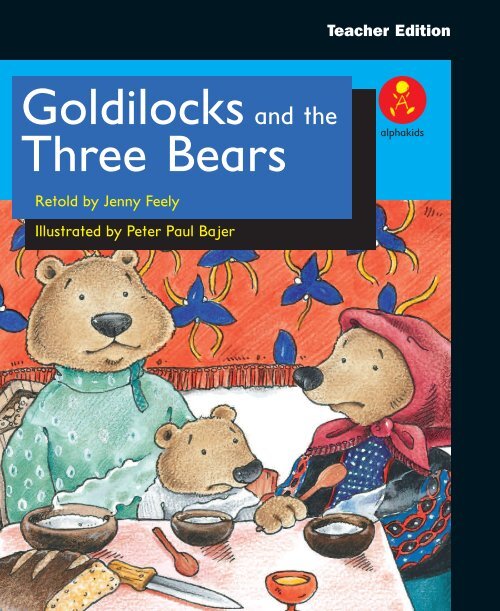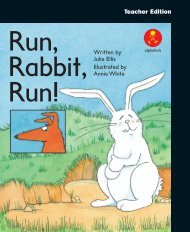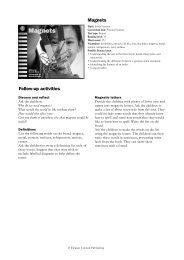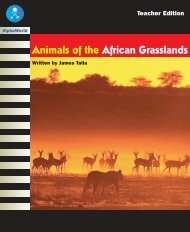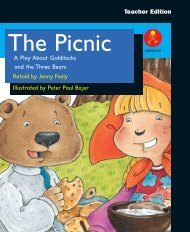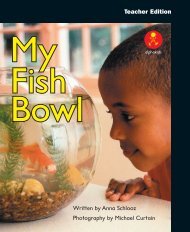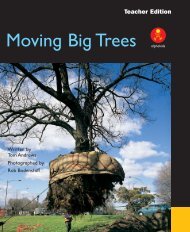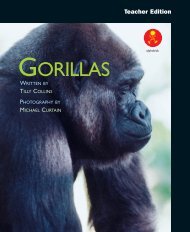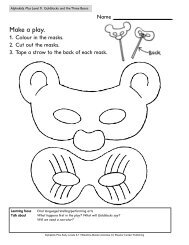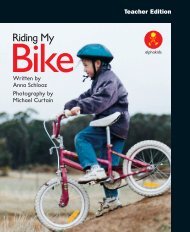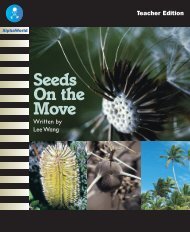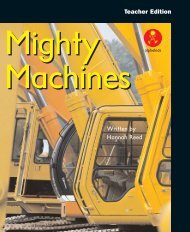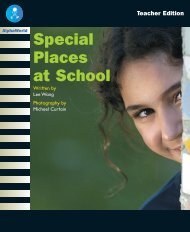Goldilocks and the Three Bears
Goldilocks and the Three Bears
Goldilocks and the Three Bears
- No tags were found...
Create successful ePaper yourself
Turn your PDF publications into a flip-book with our unique Google optimized e-Paper software.
<strong>Goldilocks</strong> <strong>and</strong> <strong>the</strong> <strong>Three</strong> <strong>Bears</strong> Pages 6–7?Talkthrough<strong>Goldilocks</strong> has broken a chair. Did <strong>Goldilocks</strong> try sitting on everychair? Whose chair did she break?Observe <strong>and</strong> supportDo <strong>the</strong> children pay attention to punctuation tosupport expressive reading?Where are <strong>the</strong> quotation marks? What do <strong>the</strong>y tell us?Where on <strong>the</strong> page are <strong>the</strong> exclamation marks? Why has <strong>the</strong>author used <strong>the</strong>se? How will you read <strong>the</strong>se sentences?Look at <strong>the</strong> word ‘CRASH!’ Why is it written in capital letters?Why does it have an exclamation mark? How will you read it?6
<strong>Goldilocks</strong> <strong>and</strong> <strong>the</strong> <strong>Three</strong> <strong>Bears</strong> Pages 8–9?Talkthrough<strong>Goldilocks</strong> is in <strong>the</strong> bedroom now. What does she do? Whathappens after she jumps on Baby Bear’s bed?Observe <strong>and</strong> supportDo <strong>the</strong> children check what <strong>the</strong>y read with <strong>the</strong> phonicinformation on <strong>the</strong> page?Point to a word such as ‘jumped’.How did you know what that word was? What did you check at<strong>the</strong> start of <strong>the</strong> word? What did you look for at <strong>the</strong> end of <strong>the</strong>word? What else did you check?8
<strong>Goldilocks</strong> <strong>and</strong> <strong>the</strong> <strong>Three</strong> <strong>Bears</strong> Pages 10–11?TalkthroughThe three bears are back home now. What have <strong>the</strong>ydiscovered? How do <strong>the</strong>y feel about this? Do any of <strong>the</strong> bearshave any porridge left? What might Baby Bear be saying?Observe <strong>and</strong> supportCan <strong>the</strong> children identify apostrophes <strong>and</strong> explainwhat <strong>the</strong>y are used for?Can you show me an apostrophe? What two words have beenshortened into one? How will you read <strong>the</strong> words with anapostrophe?10
<strong>Goldilocks</strong> <strong>and</strong> <strong>the</strong> <strong>Three</strong> <strong>Bears</strong> Pages 12–13?TalkthroughBaby Bear has found his broken chair. How would you befeeling if you were Baby Bear? What do you think <strong>the</strong> bears willdo next?Observe <strong>and</strong> supportCan <strong>the</strong> children use information from <strong>the</strong> text <strong>and</strong> <strong>the</strong>illustrations to underst<strong>and</strong> <strong>the</strong> meaning of newvocabulary, such as ‘broken’?What does <strong>the</strong> word ‘broken’ mean? How do you know this?What o<strong>the</strong>r words could you use instead of ‘broken’ that wouldkeep <strong>the</strong> meaning <strong>the</strong> same?12
<strong>Goldilocks</strong> <strong>and</strong> <strong>the</strong> <strong>Three</strong> <strong>Bears</strong> Pages 14–15?TalkthroughWho have <strong>the</strong> bears found? Whose bed is <strong>Goldilocks</strong>sleeping in? What will she do when she wakes up?Observe <strong>and</strong> supportCan <strong>the</strong> children draw inferences from <strong>the</strong> text?How did <strong>the</strong> bears feel when <strong>the</strong>y found out that someone hadbeen in <strong>the</strong>ir house?Did <strong>Goldilocks</strong> do <strong>the</strong> wrong thing going into <strong>the</strong> bears’ house?Why or why not?Would you go into someone else’s house without being invited?Why or why not?14
<strong>Goldilocks</strong> <strong>and</strong> <strong>the</strong> <strong>Three</strong> <strong>Bears</strong> Page 16? TalkthroughWhat does <strong>Goldilocks</strong> do when she wakes up? Why do you thinkshe does this?16After readingBeing a meaning makerEncourage <strong>the</strong> children to support <strong>the</strong>ir responseswith evidence from <strong>the</strong> book as <strong>the</strong>y discuss <strong>the</strong>secomprehension questions.Whose porridge did <strong>Goldilocks</strong> eat?Why didn’t <strong>Goldilocks</strong> eat Mama Bear’s porridge?How might Baby Bear feel about <strong>Goldilocks</strong>? Why?What kind of person do you think <strong>Goldilocks</strong> is?What would happen if someone did what <strong>Goldilocks</strong> did in yourhouse?
Being a code breakerExplore <strong>the</strong> following language features:• High-frequency words: a, <strong>and</strong>, for, in,it, my, of, on, said, saw, she, <strong>the</strong>y, to,up, was, went, were.• Contractions <strong>and</strong> how <strong>the</strong>y areformed; for example, someone’s, it’s.Being a text userRefer to <strong>the</strong> text when discussing <strong>the</strong>sequestions:Did you like this version of <strong>the</strong> story? Why orwhy not?How is this story <strong>the</strong> same as o<strong>the</strong>r versions?How is it different?Being a text criticThe illustrator of this book has drawn <strong>the</strong>characters as Russian peasants. How doesthis add to or change <strong>the</strong> story? Are little girlsever like <strong>Goldilocks</strong>?Responding to textAsk <strong>the</strong> children to work incooperative groups to practise <strong>and</strong>perform a readers’ <strong>the</strong>atre of <strong>the</strong> story.Provide <strong>the</strong> children with largesheets of paper, felt tip markers<strong>and</strong> pens <strong>and</strong> pencils. Encourage <strong>the</strong>m tomake a poster of <strong>the</strong>ir favourite part of<strong>the</strong> story. Their posters could includepop-up features.Ask <strong>the</strong> children to go through <strong>the</strong>book <strong>and</strong> list all <strong>the</strong> words thatcontain double letters. They could useo<strong>the</strong>r familiar texts to add to <strong>the</strong>ir lists.WritingDiscuss <strong>the</strong> setting of this version of<strong>Goldilocks</strong> <strong>and</strong> <strong>the</strong> <strong>Three</strong> <strong>Bears</strong>.Encourage <strong>the</strong> children to write <strong>the</strong>irown version of <strong>the</strong> story, using a differentsetting, such as ano<strong>the</strong>r country, <strong>the</strong>present or <strong>the</strong> future.AssessmentCan <strong>the</strong> children:• identify <strong>the</strong> type of text (traditional tale) <strong>and</strong> explain what this means?• predict what will come next in <strong>the</strong> story based on <strong>the</strong> repetitive structure of <strong>the</strong>book?whole text activity sentence activity word activity
<strong>Goldilocks</strong> <strong>and</strong> <strong>the</strong><strong>Three</strong>Baby BearGoes for <strong>Bears</strong> a WalkRetold by Jenny FeelyIllustrated by Peter Paul BajeralphakidsTeacherEditionO<strong>the</strong>rbooksat thislevelMakingMaking SpaghettiWritten by Jack HastingsSpaghettiPhotography by Michael CurtainalphakidsTopic: Traditional talesCurriculum link: EnglishText type: NarrativeReading level: 9Word count: 275High-frequency words: a, <strong>and</strong>, for, in, it, my, of,on, said, saw, she, <strong>the</strong>y, to, up, was, went, wereVocabulary: asleep, bears, broken, chair,<strong>Goldilocks</strong>, jumped, once, porridge, someone, three,time, uponPossible literacy focusExploring language associated with traditional tales;for example, ’Once upon a time’.Recognising predictable language features in a text.SummaryThis text is a retelling of <strong>the</strong> traditional tale of<strong>Goldilocks</strong> <strong>and</strong> <strong>the</strong> <strong>Three</strong> <strong>Bears</strong>.TwoSnakesalphakidsRetold by Edel Wignell Illustrated by Marjory GardnerTheFox<strong>and</strong> <strong>the</strong>SnailalphakidsRetold by Edel WignellIllustrated by Alex StittCampingalphakidsWritten by Sarah O’NeilPhotography byMichael CurtainWhalesWritten by Hannah ReedIllustrated by Liz CogleyalphakidsISBN 0- 7253- 3403- 79 780725 334031alphakids


